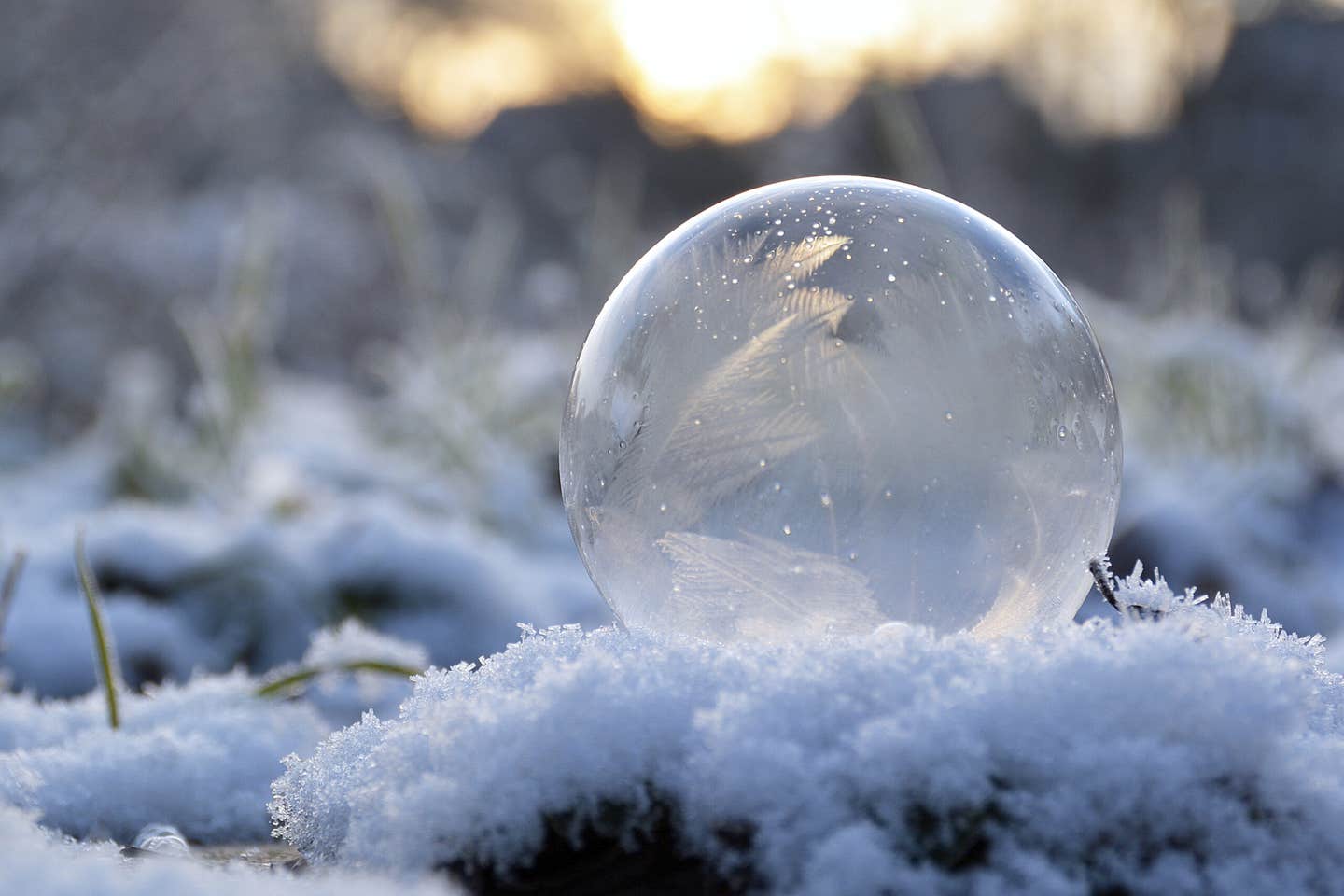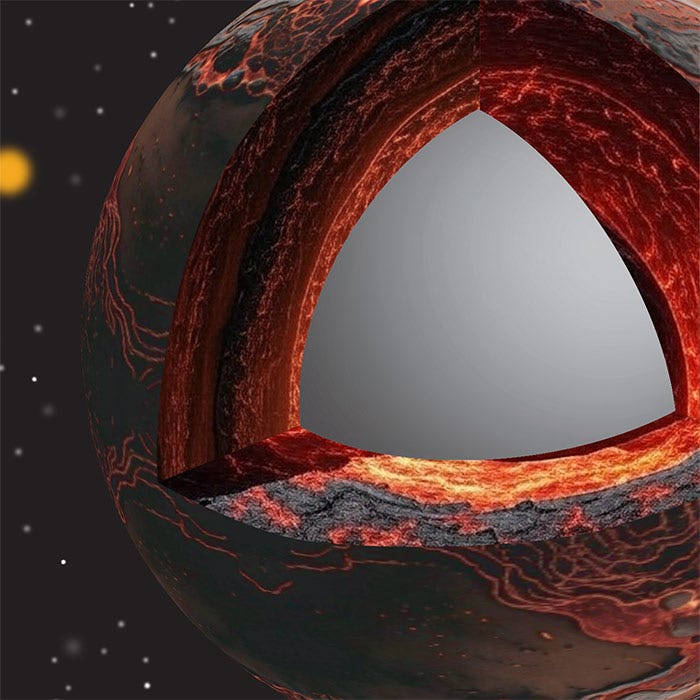Scientists discover new form of ice that freezes at room temperature
Scientists find five freezing pathways and a new ice form, ice XXI, revealing water’s hidden complexity under pressure.

A team using powerful X-ray lasers has discovered ice XXI, a new phase of water that forms at room temperature under extreme pressure. (CREDIT: Shutterstock)
Water may appear simple but behaves in ways that surprise even the world's greatest scientists. A new international study has discovered that if it is put under extreme pressure—even at room temperature—water can freeze and melt through five different paths, creating a new form of ice called ice XXI.
A Laboratory for Extreme Pressure
Researchers at the Korea Research Institute of Standards and Science (KRISS) worked with European XFEL staff in Germany, which has the world's most intense X-ray laser. They used a dynamic diamond anvil cell, a device capable of squeezing a water droplet between two diamond tips to previously unachievable precision. Depending on how much compression was achieved, pressure ranged from just 0.001 gigapascal per second to an astonishing 120 gigapascals per second—millions stronger than pressure you feel at sea level.
The group repeatedly raised and lowered the pressure between roughly 0.6 to 2.0 gigapascals, all the while maintaining a temperature of roughly 25 °C, roughly room temperature. Over hundreds of cycles, they watched water freeze and thaw over and over, and with each, they captured it in stunning detail.
To do so, they synchronized the rapid flashes of the European XFEL—pulses of X-rays a millionth of a second in duration—with the time ice began to create crystals. Those images enabled them to shoot brief "movies" of ice growth in conditions found deep in planets and moons.
Five Different Roads to Ice
Instead of moving along a single, straightforward path from liquid to solid, water was discovered to have five distinct pathways of freezing. Sometimes it froze into one of the less common forms called ice VI and then evaporated. Sometimes it passed through transient or "metastable" states, one of which has just been discovered and never seen before.
In some experiments, the cycle followed water → ice VI → water; in others, water → ice VII → ice VI → water. The most complex route had three successive solids—ice XXI, ice VII, and ice VI—before returning to liquid. The phase transitions took amazingly brief times, 20 to 40 microseconds.
Cornelius Strohm of Hamburg's DESY research center, who collaborated on the study, explained the diamond-anvil device "enables us to compress samples along predetermined pressure paths and watch what occurs in real time." The data revealed a hidden network of crystallization pathways rather than a single highway from liquid to solid.
The Birth of Ice XXI
Of all the roads, the discovery of ice XXI was especially notable. It's structurally distinct from any one of the 20-odd ice phases that were previously discovered. Its crystal lattice is "body-centered tetragonal"—a stretched-out-cube structure with symmetrical planes—and it contains 152 water molecules per unit cell. That makes it heavier than ordinary ice, which is why ordinary ice floats but this one would sink.
Around 1.6 gigapascals, the density of ice XXI is 1.413 grams per cubic centimeter. After it is formed, it doesn't reverse back to its previous stage. Rather, it moves further towards more stable ice VII and VI structures. That one-way process distinguishes it as metastable—capable of persistence for a while despite another state being more stable under the same circumstances.
KRISS scientist Geun Woo Lee demonstrated that "fast compression of water allows it to remain liquid even up to pressures where it would have already crystallized to ice VI." That window is where other unusual structures like ice XXI can break out.
Watching Atoms Remodel Themselves
In order to observe what's happening at the atomic level, the scientists paired their experiments and molecular-dynamics simulations with two computer simulations of water.
As the increasing pressure mounted to 2 gigapascals, they found that the internal structure of liquid water gradually shifted from one typical of ice VI to one typical of ice VII. That smooth adjustment in the molecular arrangement is partially why several different solid structures can develop along the way.
In fact, pressurized water doesn't actually jump from one state to another. It meanders through intermediate "neighborhoods" where molecules are partially aligned before they snap into a full crystal. Such small changes indicate that freezing isn't so much about temperature or pressure as timing—the delicate interplay between how quickly crystals form and how quickly energy can move through the fluid.
High-Speed Snapshots of a Hidden World
Capturing events that happen in millionths of a second required the best technology available. Researchers at European XFEL recorded ultra-short pulses of X-rays to capture the way in which atoms are reorganizing with every transition. Additional experiments at DESY's PETRA III laboratory confirmed the structure of ice XXI and its unusually large repeating units.
"Using the unique X-ray bursts of the European XFEL, we found multiple paths to crystallization in rapidly compressed water," Lee said. Over a thousand cycles of compression and decompression revealed the same patterns repeating again and again, suggesting the results weren't a fluke but reproducible physical processes.
Sakura Pascarelli, the scientific director of European XFEL, greeted the success: "It's fantastic to hear of another fantastic outcome from our Water Call call for proposals, encouraging scientists to explore the most basic but still mysterious liquid in the universe."
Water's richness comes from the way its molecules behave. They each can make hydrogen bonds in a multitude of directions, and when they nest together, an astonishing number of patterns are created. That flexibility is why small changes in pressure or temperature can produce wildly different configurations.
Rethinking a Familiar Substance
When water is slowly compressed, it freezes into stable forms of ice VI or VII. However, if compressed rapidly, as in this study, the liquid is "supercompressed." At this time, it can resist freezing momentarily and instead form strange structures.
Scientists think that similar processes can occur naturally in the interior of cold moons such as Titan and Ganymede, whose pressures and temperatures are great enough to create exotic types of ice. "Our work suggests a greater number of metastable ice phases at high temperatures, giving us new insight into the structure of icy moons," DESY HIBEF scientist Rachel Husband said.
The study contradicts traditional wisdom about water's behavior. Scientists formerly presumed that ice VI dominated the range between 1 to 2 gigapascals. Today they understand that this region holds an active landscape of competing phases, each developed by slight differences in molecule structure and how quickly pressure changes.
Even at room temperatures, high-pressure water is not in the mood to play by the rules. It will freeze, melt, and remelt in the blink of an eye, forming temporary structures that reveal how dynamic this everyday liquid really is.
As one researcher pointed out, every drop contains "a whole world waiting to be discovered—if only you squeeze hard enough."
Practical Implications of the Research
The discovery of ice XXI contributes to our understanding of water's behavior under extreme conditions, such as the centers of the giant planets and icy moons where pressures reach millions of times that of Earth's atmosphere. Knowledge of how water migrates between its many solid phases can help planetary scientists unravel signals returned from missions examining the Jupiter and Saturn moons.
The work is also a boost to materials science, whose power to control the way substances crystallize is central to the production of high-performance alloys, semiconductors, and drugs.
Beyond its practical applications, this research reminds us that even the simplest molecule in nature still holds secrets that can redefine our understanding of the universe.
Research findings are available online in the journal Nature Materials.
Related Stories
- Space ice is less like water than scientists thought, study finds
- Mars glaciers found to be 80% ice - could fuel future human settlements
- Massive Martian ice deposit could flood entire planet under 9 feet of water
Like these kind of feel good stories? Get The Brighter Side of News' newsletter.
Mac Oliveau
Science & Technology Writer
Mac Oliveau is a Los Angeles–based science and technology journalist for The Brighter Side of News, an online publication focused on uplifting, transformative stories from around the globe. Passionate about spotlighting groundbreaking discoveries and innovations, Mac covers a broad spectrum of topics—from medical breakthroughs and artificial intelligence to green tech and archeology. With a talent for making complex science clear and compelling, they connect readers to the advancements shaping a brighter, more hopeful future.



